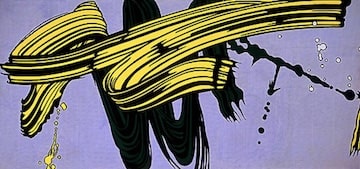Yellow and Green Brushstrokes, 1965 by Roy Lichtenstein

In 1965 Lichtenstein began a series of paintings of brushstrokes that have been interpreted as a commentary on the New York School of action paintings. He has since stated that he want to make
a statement about the tradition of painting as we know it from the time of Italian Renaissance. Lichtenstein conceptualized the idea of the bravura brushstroke and render it in his usual cool
and detached style. As he had done in the cartoons, he first executed paintings like Yellow and Green Brushstrokes as small studies which he then enlarged in an opaque projector and
redrew on the surface of his canvases.
Measuring 84 in x 180 in, Yellow and Green Brushstrokes is regarded as quite notable for its ability to imply perceptible movement although his works is limited
to a single image on a canvas with finite space. The movement is considered similar to the explosive actions evident in earlier works such as Whaam!. He uses overlapping
forms rather than a single form or distinct adjacent forms, which seems to create a more dynamic feel to the shallow space. However, since Lichtenstein does not uses shading or contrast,
the monochromatic strokes with just bold black outlines are void of certain elements of depth.
The notion of making a brushstroke into a concrete form, even to the extent of cleaning up the drips, enabled him to restate in his own language the history of painterliness from Frans Hals
to the Abstract Expressionists. Since painterliness is often synonymous with style, Yellow and Green Brushstrokes can also be seen as a commentary on the nature of the act of painting.
In his transformation of the isolated brushstroke, however, Lichtenstein succeeds in capturing a larger quarry: art itself.
